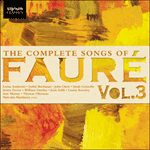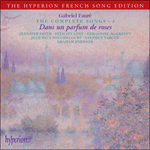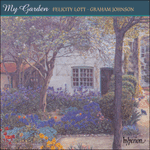This is among the most sensual and erotic, even decadent, of Fauré’s mélodies. Jankélévitch judges its self-consciousness as unworthy of the real Fauré, but the musical public has always adored its highly perfumed sumptuousness. If this suggests a seraglio draped in the opulent Parisian style of the 1880s, the zeitgeist is partly to blame: Huysmans’s
À rebours appeared alongside Leconte de Lisle’s
Poèmes tragiques in 1884. There is a unique undulation to this music that is partly created by a counter-melody, like a third voice, between the thumbs of the accompanist’s hands. This gait, leisurely and majestic, varied by occasional rhythmic displacements, suggests heavily loaded camels swaying across the desert sands (cf Chausson’s
La caravane, 1887). Every kind of rare perfume is for sale here, but nothing can match the fragrance of the absent Leilah. The song’s journey is suddenly interrupted by a personal aside: we had been expecting another appearance of the sinuous and hypnotic refrain (and indeed the song closes with this music), but with ‘Ô Leïlah!’ there is a sudden outburst; the lack of a preceding interlude makes it seem spontaneous, unplanned. This middle strophe alone, one of Fauré’s most heartfelt utterances, saves the song from relegation into the ranks of that overpopulated genre in French music, the oriental pastiche. The poem has six verses of which the composer sets 1,2, 4 and 6.
from notes by Graham Johnson © 2005
Il s’agit là de l’une des plus sensuelles, des plus érotiques, voire des plus décadentes mélodies de Fauré. Jankélévitch juge son côté déterminé indigne du vrai Fauré, mais le public mélomane a toujours adoré sa somptuosité extrêmement parfumée. Si elle suggère l’image d’un sérail drapé dans l’opulent style parisien des années 1880, c’est un peu le Zeitgeist qu’il faut blâmer :
À rebours de Huysmans est paru en 1884, la même année que les
Poèmes tragiques de Leconte de Lisle. Cette musique a une ondulation bien à elle, née en partie d’une contre-mélodie, semblable à une troisième voix partagée aux deux pouces de l’accompagnateur. Cette démarche, nonchalante et majestueuse, qui varie au gré d’occasionnels déplacements rythmiques, évoque des chameaux lourdement chargés, avançant d’un pas chaloupé dans les sables du désert (cf.
La caravane de Chausson, 1887). Toutes sortes de parfums rares sont à vendre, mais aucun ne saurait égaler celui de l’absente Leïlah. Le voyage de la mélodie est soudain interrompu par un aparté de Fauré : on s’attendait à une nouvelle apparition du refrain sinueux et hypnotique (et, de fait, la mélodie s’achève sur lui), mais les mots « Ô Leïlah » s’accompagnent d’un brusque déchaînement qu’aucun interlude ne précède, qui semble spontané, impromtu. Cette strophe médiance, l’une des énonciations les plus sincères du compositeur, suffit à ne pas reléguer
Les roses d’Ispahan dans ce genre pléthorique de la musique française qu’est le pastiche oriental. Seules quatre des six strophes du poème ont été mises en musique : les nos 1, 2, 4 et 6.
extrait des notes rédigées par Graham Johnson © 2005
Français: Hypérion


 Fauré: The Complete Songs, Vol. 3
Fauré: The Complete Songs, Vol. 3 Fauré: The Complete Songs, Vol. 4 - Dans un parfum de roses
Fauré: The Complete Songs, Vol. 4 - Dans un parfum de roses My Garden
My Garden
